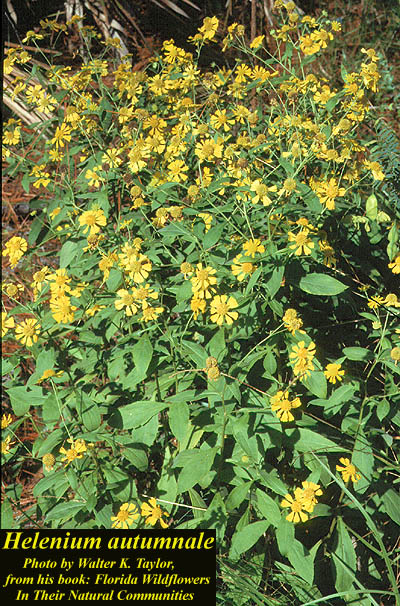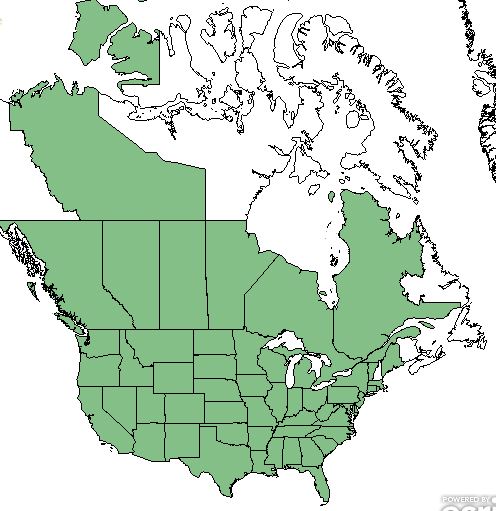Helenium autumnale
Common name: common sneezeweed
| Helenium autumnale | |
|---|---|

| |
| Photo by the Atlas of Florida Plants Database | |
| Scientific classification | |
| Kingdom: | Plantae |
| Division: | Magnoliophyta - Flowering plants |
| Class: | Magnoliopsida - Dicots |
| Order: | Asterales |
| Family: | Asteraceae |
| Genus: | Helenium |
| Species: | H. autumnale |
| Binomial name | |
| Helenium autumnale L. | |

| |
| Natural range of Helenium autumnale from USDA NRCS Plants Database. | |
Contents
Taxonomic Notes
Synonyms: Helenium latifolium P. Miller, and Helenium parviflorum Nuttall; H. autumnale L. var. parviflorum (Nuttall) Fernald; H. autumnale L. var. autumnale
Description
Also known as the common sneezeweed, H. autumnale is a native perennial forb that is a member of the Asteraceae family. It grows yellow conspicuous flowers and brown inconspicuous fruit [1].
Distribution
H. autumnale can be found across the North American continent, from across the United States to most of Canada [1].
Ecology
Habitat
This species grows in a variety of communities, ranging from moist pastures to forests and woodlands. [2] More specifically, habitats range from shady and loamy sand in mesic hardwoods floodplains, sandy alluvial dikes, drainage ditches, pine flatwood depressions, wet woodlands, wet roadsides, moist soil of limestone bluffs, and other moist sandy loams. [3]
Phenology
Generally, H. autumnale flowers from September until October.[2] It has been observed to flower in September [4], but has been seen to be flowering in the months of June through November. It has been seen to develop fruit in the months June through November as well. [3]
Use by animals
It is considered bitter and unpalatable to grazing animals which in turn makes it more abundant in pastures.[2]
Conservation and Management
This species is considered to be weedy or invasive in Nebraska and the Great Plains region.[1]
Cultivation and restoration
Photo Gallery
References and notes
- ↑ 1.0 1.1 1.2 USDA Plants Database URL: https://plants.usda.gov/core/profile?symbol=HEAU
- ↑ 2.0 2.1 2.2 Weakley A. S.(2015). Flora of the Southern and Mid-Atlantic States. Chapel Hill, NC: University of North Carolina Herbarium.
- ↑ 3.0 3.1 Florida State University Robert K. Godfrey Herbarium database. URL: http://herbarium.bio.fsu.edu. Last accessed: June 2018. Collectors: Loran C. Anderson, Robert L. Lazor, Robert K. Godfrey, D. B. Ward, R. Kral, L. Redfeam, and J. Lazor. States and counties: Florida: Liberty, Jackson, Taylor, Wakulla, Montgomery, Franklin, Gadsden, Calhoun, Holmes, and Gulf. Georgia: Thomas.
- ↑ Nelson, G. PanFlora: Plant data for the eastern United States with emphasis on the Southeastern Coastal Plains, Florida, and the Florida Panhandle. www.gilnelson.com/PanFlora/ Accessed: 22 MAY 2018